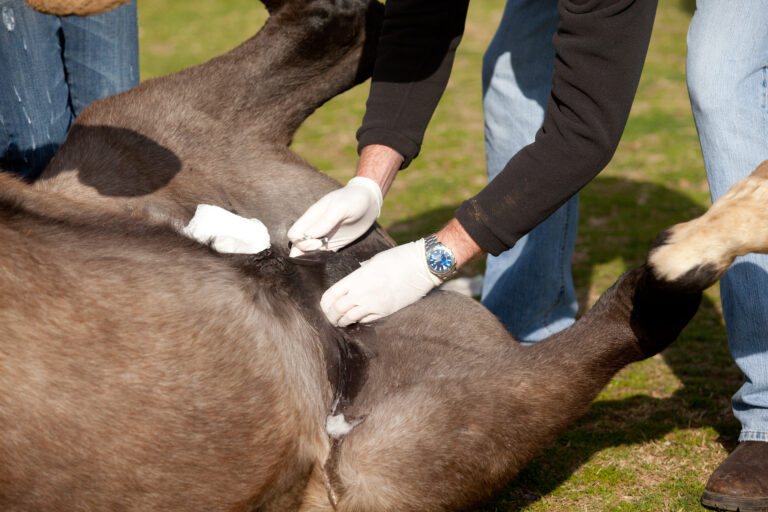
Horses evolved eating diets that are high in fiber. While veterinarians and most horse owners understand that, it’s good to help clients “return to basics” in feeding their horses a forage-first diet.
About 60% of a horse’s digestive tract volume is dedicated to forage fermentation, according to Clair Thunes, MS, PhD, an equine nutrition consultant and owner of Clarity Equine Nutrition. “To honor that digestive anatomy, it is important that forage makes up the majority of the diet for most horses,” she said.
Providing forage first helps to get the gut working positively, according to Robert Coleman, PAS, PhD, an equine extension specialist for the University of Kentucky. Plus, giving hay first takes the edge off the horse’s hunger. Slowing a horse’s feed intake reduces choke risks and encourages healthy gut functions.
“Feeding hay first means more saliva production and better stomach buffering, which means fewer issues with stomach acid and hopefully a happier horse,” Coleman said. “Even in cases of horses coming in after being outside in a paddock, having hay to start the meal will help reduce eating too fast.”
One misperception Thunes finds horse owners have about a forage-based diet is that forage is only for bulk and serves no other purpose than to “fill the horse up.”
“That is simply not true,” she said. “Horses can gain a large number of calories from fermented forage. Forages also provide many other important nutrients such as protein and minerals.”
The maturity level of the forage influences the available nutrients, so it might not provide everything in the horse’s diet. But it is the place to start when building a feeding plan for a horse. Here’s what you need to know about designing a forage-first diet.

Forage-First Diets
A quality forage source should make up at least 50% of the horse’s daily diet. Alternatively, in a forage-first diet horses ideally should eat at least 1.5% of their body weight per day as forage, said Thunes. That equates to about 18 pounds of forage for a 1,200-pound horse. Ideally, they have access to more.
Hay is often equated with a forage-first ration, but a forage diet also includes pasture. The nutritional value of forage varies geographically and by the forage type. This also factors into the forage volume a horse needs.
“In northern climates, pasture grasses are typically cold-season varieties such as rye species, bluegrass or orchard grass, perhaps with some clover mixed in,” noted Thunes. “In more southern climates, warm-season varieties such as Bahia Grass and Bermuda Grass will be more common. Legumes like alfalfa and peanut hay are common in horse diets.”
Generally, grass hays tend to be lower in calories, but sugars can be high. Protein levels are higher in legume hays. However, Thunes said it is impossible to make a blanket statement that applies to all hay types. Growing conditions more than forage species influence the amount of non-structural carbohydrates (NSC).
“The legume hays are considerably higher in protein as they are nitrogen fixers,” said Thunes. “Therefore, they will typically have higher calcium contents and provide more calories per pound. The higher calcium and protein make them good at buffering stomach acid. Therefore, they can be useful in horses prone to gastric ulcers. But the higher calorie content makes them a challenge for easier keepers.”
When Thunes suggests that clients feed legume hay, she limits the ration to 25-30% of the total forage intake, with the balance coming from grass hays.
Evaluating Forage Quality
Helping your clients evaluate hay quality is essential in designing a forage-first diet. Quality is typically judged based on smell, feel and visual appearance. Generally, hay should be fine-stemmed, green and leafy.
“It should have a sweet smell and be free of any mold,” said Sue Arnold, executive director of the National Hay Association. “Avoid hay that is excessively bleached or discolored or smells musty, dusty or fermented.”
Arnold offers these tips for visually evaluating hay:
Color: Ideally, it should be good green color. Hay that is beige in hue indicates that it has been sun bleached or subjected to rain. Dark brown hay might point to heat damage.
Maturity: Hay cut at a later stage of maturity is less digestible and has less crude protein than hay cut earlier. It will also be coarser and have more seed heads. Ideally, hay will feel soft to the touch, as it should have fine stems and lots of leaves.
Free of dust and mold: Mold often appears as clumps in the middle of the hay. Banging two flakes of hay together is an excellent way to see how much dust is present.
Free of weeds, pests and foreign materials: A good look at several hay bales is the best way to ensure it does not contain excessive weeds (some weeds are inevitable). Hay should also be free of pests—such as blister beetles—and foreign material such as garbage.
“A visual inspection cannot determine the nutrient content of a hay, but the appearance can be an indication of overall quality,” Arnold said.
Defining quality forage is always a challenge, Coleman said. It requires taking samples from about 20 bales and sending the samples to a lab for analysis. That analysis provides a clearer picture of what nutrients are available, which ones are missing and when supplementation might be necessary.
A basic nutrient analysis should include:
- digestible energy (DE)
- crude protein (CP)
- dry matter (DM)
- calcium (Ca)
- phosphorus (P)
- potassium (K)
- acid detergent fiber (ADF)
- neutral detergent fiber (NDF)
“The horse I am feeding hay to must also be considered,” Coleman said. “A slightly overweight horse that eats everything might be better off with something a little lower in digestible nutrients to help with weight.”
On an analysis, Coleman first looks at the hay’s moisture or dry matter level. He prefers moisture levels no higher than 16.5% or dry matter equivalent to 83.5% or higher.
“Moisture levels above 16.5% have a greater risk of mold formation during storage unless the hay has been treated with a preservative,” he said.
Getting a nutrient analysis is ideal, but if a client buys hay by the month, it might not be practical as the hay might come from different fields and have been grown under varying conditions.

Finding (and Stretching) Forage Supplies
Sourcing hay is becoming more challenging. According to Arnold, initial indications are that U.S. acreage devoted to dry hay production in 2022 could be the lowest in 115 years. U.S. producers intend to harvest 50.3 million acres of all hay in 2022, down 1% from 2021.
“If realized, this will represent the lowest total hay harvested area since 1907,” stated Arnold. “Oklahoma, Texas and Tennessee are expected to see the largest drop in dry hay acreage. There is forage available this year. And while prices per ton have increased, a major impact seems to be the transportation costs and logistic challenges. So overall, prices are up from 2021.”
High-fiber hay extender feeds can replace all or some of the hay in a horse’s forage-first diet. However, you should pay attention to whether these pellets are fortified, as this can impact whether they can be fed with other fortified commercial feeds.
“Some hay extenders are complete, meaning [they have] added minerals and vitamins and, if combined with other fortified feeds, could result in an excess intake of some nutrients, especially minerals,” Thunes said.
Nutritionally, alfalfa pellets and cubes may provide the same essential nutrients per pound, according to Arnold. However, alfalfa cubes are more appropriate for lactating mares or growing horses and as a partial forage substitute. While up to 15 pounds or more can be fed daily, as little as two to six pounds of cubes per day can be used as a “hay extender” if only poor-quality hay is available.
“Forage cubes or pellets can be fed just like hay at a 1:1 ratio of the hay type the horse currently consumes,” Thunes said. “For example, you would replace five pounds of alfalfa hay with five pounds of alfalfa cubes and adjust the amount if needed to maintain the animal’s proper weight. These pellets can be used if forage is in short supply. With processed products, horse owners can easily weigh the material and know how much they feed.”
The Bottom Line
Vets should help their clients understand that the majority of a horse’s diet should consist of forage. This supports the horse’s natural digestive anatomy, which is designed to ferment grasses and hays. Forage-first diets also encourage saliva production, which in turn acts as a buffering agent in the stomach to help reduce gastric upset or even ulcers.
“There are commercial feeds that are called forage-first and generally are a higher-fiber feed,” said Coleman. “More fiber means more chewing, which means more saliva production, which means better stomach buffering. More stomach buffering means less gastric issues and hopefully a happier horse.”




